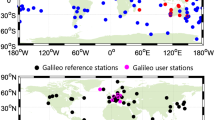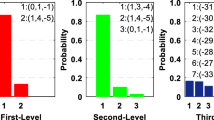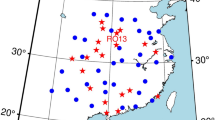Abstract
All BeiDou navigation satellite system (BDS) satellites are transmitting signals on three frequencies, which brings new opportunity and challenges for high-accuracy precise point positioning (PPP) with ambiguity resolution (AR). This paper proposes an effective uncalibrated phase delay (UPD) estimation and AR strategy which is based on a raw PPP model. First, triple-frequency raw PPP models are developed. The observation model and stochastic model are designed and extended to accommodate the third frequency. Then, the UPD is parameterized in raw frequency form while estimating with the high-precision and low-noise integer linear combination of float ambiguity which are derived by ambiguity decorrelation. Third, with UPD corrected, the LAMBDA method is used for resolving full or partial ambiguities which can be fixed. This method can be easily and flexibly extended for dual-, triple- or even more frequency. To verify the effectiveness and performance of triple-frequency PPP AR, tests with real BDS data from 90 stations lasting for 21 days were performed in static mode. Data were processed with three strategies: BDS triple-frequency ambiguity-float PPP, BDS triple-frequency PPP with dual-frequency (B1/B2) and three-frequency AR, respectively. Numerous experiment results showed that compared with the ambiguity-float solution, the performance in terms of convergence time and positioning biases can be significantly improved by AR. Among three groups of solutions, the triple-frequency PPP AR achieved the best performance. Compared with dual-frequency AR, additional the third frequency could apparently improve the position estimations during the initialization phase and under constraint environments when the dual-frequency PPP AR is limited by few satellite numbers.









Similar content being viewed by others
References
Arikan F, Nayir H, Sezen U, Arikan O (2008) Estimation of single station interfrequency receiver bias using GPS-TEC. Radio Sci 43, RS4004
Banville S (2016) Glonass ionosphere-free ambiguity resolution for precise point positioning. J Geod 90(5):487–496
Boehm J, Niell A, Tregoning P, Schuh H (2006) Global Mapping Functions (GMF): a new empirical mapping function based on numerical weather model data. Geophys Res Lett 33:L07304. https://doi.org/10.1029/2005GL025546
Chen JP, Zhang YZ, Wang JG, Yang SN, Dong DN, Wang JX, Qu WJ, Wu B (2015) A simplified and unified model of multi-GNSS precise point positioning. Adv Space Res 55(1):125–134
Collins P, Lahaye F, Héroux P, Bisnath S, (2008) Precise point positioning with ambiguity resolution using the decoupled clock model. In: Proceedings of ION GNSS, (2008) Institute of Navigation. Savannah, Georgia, pp 1315–1322
deLacy MC, Reguzzoni M, Sansoò F (2012) Real-time cycle slip detection in triple-frequency GNSS. GPS Solut 16(3):353–362
Deng Z, Zhao Q, Springer T, Prange L, Uhlemann M (2014) Orbit and Clock Determination-BeiDou, IGS workshop, Pasadena, USA, 23.06-27.06.2014
Deo M, El-Mowafy A (2016) Triple-frequency GNSS models for PPP with float ambiguity estimation: performance comparison using GPS. Surv Rev. https://doi.org/10.1080/00396265.2016.1263179
Elsobeiey M (2015) Precise point positioning using triple-frequency GPS measurements. J Navig 68:480–492
Forssell B, Martin-Neira M, Harris RA (1997) Carrier phase ambiguity resolution in GNSS-2. In: Proceedings ION GPS-1997, Institute of Navigation, Kansas City, Missouri, Sept, pp 1727–1736
Ge M, Gendt G, Rothacher M, Shi C, Liu J (2008) Resolution of GPS carrier-phase ambiguities in precise point positioning (PPP) with daily observations. J Geod 82(7):389–399
Geng J, Bock Y (2013) Triple-frequency GPS precise point positioning with rapid ambiguity resolution. J Geod 87(5):449–460
Geng J, Shi C (2017) Rapid initialization of real-time PPP by resolving undifferenced GPS and GLONASS ambiguities simultaneously. J Geod 91(4):361–374
Gu SF, Lou YD, Shi C, Liu JN (2015) BeiDou phase bias estimation and its application in precise point positioning with triple-frequency observable. J Geod 89(10):979–992
Guo F, Zhang XH, Wang JL (2015) Timing group delay and differential code bias corrections for BeiDou positioning. J Geod 89(5):427–445
Guo F, Zhang XH, Wang JL, Ren XD (2016) Modeling and assessment of triple-frequency BDS precise point positioning. J Geod 90(11):1223–1235
Ji S, Chen W, Ding X, Chen Y, Zhao C, Hu C (2010) Ambiguity validation with combined ratio test and ellipsoidal integer aperture estimator. J Geod 84(10):597–604
Kouba J, Héroux P (2001) Precise point positioning using IGS orbits and clock products. GPS Solut 5(2):12–28
Laurichesse D, Mercier F, Berthias JP, Broca P, Cerri L (2009) Integer ambiguity resolution on undifferenced GPS phase measurements and its application to PPP and satellite precise orbit determination. Navigation 56(2):135–149
Li B, Feng Y, Shen Y (2010) Three carrier ambiguity resolution: distance-independent performance demonstrated using semigenerated triple frequency GPS signals. GPS Solut 14(2):177–184
Li H, Li B, Lou L, Yang L, Wang J (2017a) Impact of GPS differential code bias in dual- and triple-frequency positioning and satellite clock estimation. GPS Solut 21(3):897–903
Li P, Zhang XH (2015) Precise point positioning with partial ambiguity fixing. Sensors 15(6):13627–13643
Li P, Zhang XH, Guo F (2017b) Ambiguity resolved precise point positioning with GPS and Beidou. J Geod 91(1):25–40
Li X, Ge M, Dai X, Ren X, Fritsche M, Wickert J, Schuh H (2015) Accuracy and reliability of multi-GNSS real-time precise positioning: GPS, GLONASS, BeiDou, and Galileo. J Geod 89(6):607–635
Lou Y, Liu Y, Shi C, Yao XG, Zheng F (2014) Precise orbit determination of BeiDou constellation based on BETS and MGEX network. Sci Rep 4:4692
Melbourne WG (1985) The case for ranging in GPS-based geodetic systems. In: Proceedings of the first international symposium on precise positioning with the global positioning system, Rockville, 15–19 April, pp 373–386
Pan L, Zhang X, Li X, Jingnan Liu, Xin Li (2017) Characteristics of inter-frequency clock bias for Block IIF satellites and its effect on triple-frequency GPS precise point positioning. GPS Solut 21(2):811–822
Petit G, Luzum B, (2010) IERS Technical Note No. 36, IERS Conventions, (2010) International Earth Rotation and Reference Systems Service. Frankfurt, Germany
Ren X, Zhang X, Xie W, Zhang K, Yuan Y, Li X (2016) Global ionospheric modelling using multi-GNSS: BeiDou, Galileo, GLONASS and GPS. Sci Rep 6:33499
Rebischung P, Altamimi Z, Ray J, Garayt B (2016) The IGS contribution to ITRF2014. J Geod 90(7):611–630
Simsky A (2006) Three’s the charm: triple-frequency combinations in future GNSS. InsideGNSS:38-41, July/August
Teunissen PJG (1995) The least-squares ambiguity decorrelation adjustment a method for fast GPS integer ambiguity estimation. J Geod 70(1–2):65–82
Teunissen PJG, Joosten P, Tiberius C (2002) A comparison of TCAR, CIR and LAMBDA GNSS ambiguity resolution. In: Proceedings of the ION GPS-2002, pp 2799–2808, Portland, OR, 24–27 September
Wanninger L, Beer S (2015) BeiDou satellite-induced code pseudorange variations: diagnosis and therapy. GPS Solut 19(4):639–648
Wu JT, Wu SC, Hajj GA, Bertiger WI, Lichten SM (1993) Effects of antenna orientation on GPS carrier phase. Manuscripta Geod 18(2):91–98
Wubbena G (1985) Software developments for geodetic positioning with GPS using TI-4100 code and carrier measurements. In: Proceedings of first international symposium on precise positioning with the global positioning system, Rockville, 15–19 April, pp 403–412
Zhang X, He X (2016) Performance analysis of triple-frequency ambiguity resolution with BeiDou observations. GPS Solut 20(2):269–281
Zhang XH, Li P (2013) Assessment of correct fixing rate for precise point positioning ambiguity resolution on global scale. J Geod 87(6):579–589
Zhang XH, Li P (2016) Benefits of the third frequency signal on cycle slip correction. GPS Solut 20(3):451–460
Zhang XH, Wu MK, Liu WK, Li XX, Yu S, Lv CX, Wickert Y (2017) Initial assessment of the COMPASS/BeiDou-3: new-generation navigation signals. J Geod. https://doi.org/10.1007/s00190-017-1020-3
Zumberge JF, Heflin MB, Jefferson DC, Watkins MM, Webb FH (1997) Precise point positioning for the efficient and robust analysis of GPS data from large networks. J Geophy Res 102(B3):5005–5017
Acknowledgements
This study was supported by the National Natural Science Foundation of China (Grant No. 41474025, 41374035, 41304005).
Author information
Authors and Affiliations
Corresponding author
Rights and permissions
About this article
Cite this article
Li, P., Zhang, X., Ge, M. et al. Three-frequency BDS precise point positioning ambiguity resolution based on raw observables. J Geod 92, 1357–1369 (2018). https://doi.org/10.1007/s00190-018-1125-3
Received:
Accepted:
Published:
Issue Date:
DOI: https://doi.org/10.1007/s00190-018-1125-3




